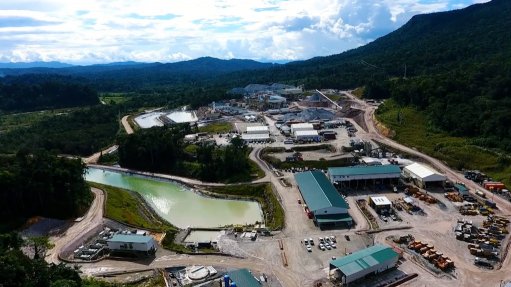Maximum value must be derived from mines, especially in challenging market
State-owned research council for the minerals industry Mintek is investigating the recovery of iron-ore waste material, in the form of fines, in an attempt to help mines extract the maximum possible value from their operations.
This is especially important in the current economic conditions, notes Mintek business development GM Peter Craven, who says Mintek’s activity has seen a dip in line with the decline in the iron-ore market over the past few years. He adds that, because of the overhanging capacity in iron-ore, the price – which is currently below $50/t – is likely to remain depressed for “quite a few years to come”, although he does foresee it improving in the long term.
Craven maintains that it is imperative that mines research methods for increasing the value they extract from their operations. “Minerals commodities are a dwindling resource, thus, it is imperative from an economic standpoint, but also from a philosophical and almost moral perspective, that we ensure that we exploit them to their full potential.”
“Traditionally, only coarse material produced by mines was sold, while all the fines were stockpiled. This has resulted in huge fines dumps in South Africa. We have, therefore, been looking at how value can be extracted from these dumps by investigating what processes can recover a good-quality fines product,” elaborates Mintek specialist consultant Carl Bergmann.
Craven notes that two techniques are currently under the spotlight in terms of iron-ore fines recovery, namely the reflux classifier – a modern density separator for fine materials – and pulsed wet high-intensity magnetic separation, better known as Whims. Both techniques are being tested at various sites around South Africa.
Craven points out that mining companies are looking for options that do not require a capital outlay and can either trim costs and/or add value to their operations. “The recovery of refuse material is, thus, a key focus as this will go directly to improving their bottom line.
“Fines are seen as a quick win in the iron-ore industry – they are liberated already and, for only a marginal additional cost, the productivity of mines can be assisted in these difficult times,” adds Bergmann.
He explains that steelmakers can accept a certain tolerance of fine material in the iron-ore they use, particularly if it is a high grade. Fines are, thus, often blended into coarser fractions of iron-ore and this combination is sold for steelmaking.
Fines recovery is, moreover, particularly well-suited to iron-ore production in South Africa, as it is often considered to be of a slightly higher grade than that produced in other countries. South Africa cannot compete with Australia and Brazil in terms of the quantity of iron-ore produced; however, it can compete in terms of quality. South African iron-ore is often used as a ‘sweetener’ that can be blended with lower-grade ores to meet specific requirements,” says Craven.
He adds that the present downturn in the market should be viewed by companies as an opportunity to conduct research and development that can improve their cost management, increase their profit margins and enhance the outputs of their existing facilities.
“Very few companies, if any, are looking to bring any new projects on line in the iron-ore sector at the moment. “All of the work we are doing is, thus, focused on squeezing every ounce of value from existing resources and existing plants to improve production, and add products with minimal effort and cost requirements,” says Craven.
However, he notes that, under the tremendous pressure of the current low iron-ore price, companies have been hesitant to make this a real priority, fearing any added expenditure.
Bergmann adds that another major area of research being conducted by Mintek is based on the expectation that the iron-ore mined in the future will be more difficult to treat than that being produced at present, with much of the high-grade material having been mined out. Processing this material will no longer only be a case of crushing and screening before being sold, he explains, but will require additional upgrading processes. “As the ores become more difficult, Mintek is looking at what technologies we can develop [to] get those ores back up to standard.”
Comments
Press Office
Announcements
What's On
Subscribe to improve your user experience...
Option 1 (equivalent of R125 a month):
Receive a weekly copy of Creamer Media's Engineering News & Mining Weekly magazine
(print copy for those in South Africa and e-magazine for those outside of South Africa)
Receive daily email newsletters
Access to full search results
Access archive of magazine back copies
Access to Projects in Progress
Access to ONE Research Report of your choice in PDF format
Option 2 (equivalent of R375 a month):
All benefits from Option 1
PLUS
Access to Creamer Media's Research Channel Africa for ALL Research Reports, in PDF format, on various industrial and mining sectors
including Electricity; Water; Energy Transition; Hydrogen; Roads, Rail and Ports; Coal; Gold; Platinum; Battery Metals; etc.
Already a subscriber?
Forgotten your password?
Receive weekly copy of Creamer Media's Engineering News & Mining Weekly magazine (print copy for those in South Africa and e-magazine for those outside of South Africa)
➕
Recieve daily email newsletters
➕
Access to full search results
➕
Access archive of magazine back copies
➕
Access to Projects in Progress
➕
Access to ONE Research Report of your choice in PDF format
RESEARCH CHANNEL AFRICA
R4500 (equivalent of R375 a month)
SUBSCRIBEAll benefits from Option 1
➕
Access to Creamer Media's Research Channel Africa for ALL Research Reports on various industrial and mining sectors, in PDF format, including on:
Electricity
➕
Water
➕
Energy Transition
➕
Hydrogen
➕
Roads, Rail and Ports
➕
Coal
➕
Gold
➕
Platinum
➕
Battery Metals
➕
etc.
Receive all benefits from Option 1 or Option 2 delivered to numerous people at your company
➕
Multiple User names and Passwords for simultaneous log-ins
➕
Intranet integration access to all in your organisation


















